The Kavli Foundation Invests in the Future of Scientific Discovery at KITP
April 30, 2021
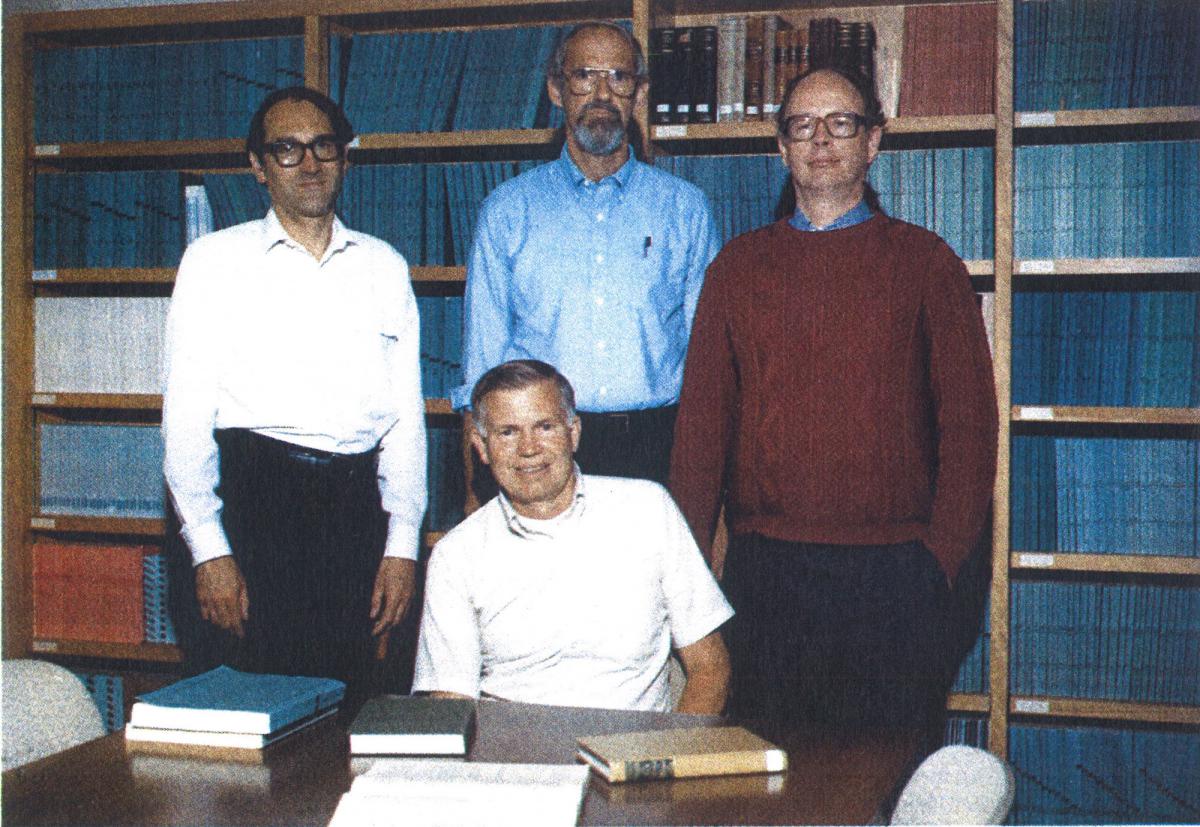 Photo credit: Will Swalling
Photo credit: Will Swalling
The “Gang of Four” then (above from L-R: Bob Sugar, Doug Scalapino, Ray Sawyer and Jim Hartle) and now (below)
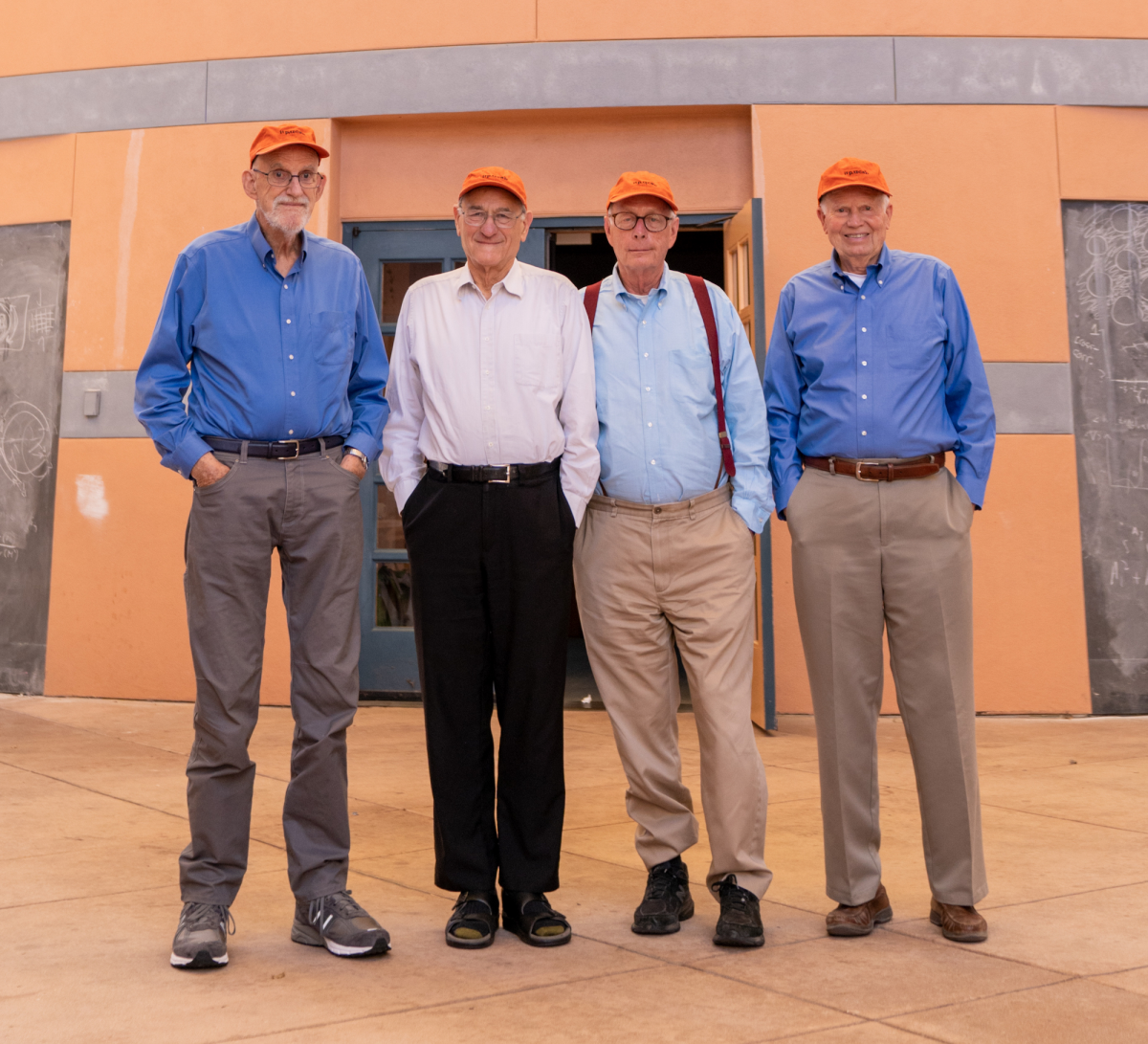 Photo credit: Mia Nie
Photo credit: Mia Nie
Theoretical physics is perhaps defined more easily by what it isn’t than what it is. It doesn’t involve experiments or looking through a telescope. Often, a theoretical physicist’s pursuit is for the deep understanding of the mathematical construct that allows them to make quantitative predictions.
“In some fields of physics, it’s really to discover and reveal the laws of nature and it often motivates experimental work,” says Lars Bildsten, director of the Kavli Institute for Theoretical Physics, and the Gluck Professor of Theoretical Physics at the University of California, Santa Barbara (UCSB). “Within the fields of astrophysics and biology, it’s much more about using the physics that we know to reveal a deeper understanding of an observed phenomena.”
Back in the 1970s, James Hartle, Raymond Sawyer, Douglas Scalapino, and Robert Sugar, faculty members of the UCSB Physics Department known as the “Gang of Four,” came up with the idea of convening scientists for long periods of interaction about theoretical physics. As they envisioned, the Institute for Theoretical Physics was established on campus in 1979 with funding from the National Science Foundation (NSF), which continues to this day.
NSF funding is a crucial part of the budget that supports the core of KITP’s visiting scientist program. It’s enhanced by grants from the Heising-Simons Foundation, the Gordon and Betty Moore Foundation, and the Simons Foundation to support early career scientists.
In 2001, Fred Kavli’s naming gift enabled the expansion of Kohn Hall, which provided the space for the research program to grow in new directions. This gift not only expanded the building and programming, but also led to continued growth through a diversification of private support.
The Kavli Foundation continues to support KITP with yearly gifts. In the fall of 2020, it made an additional endowment gift of $5M, which will be recognized through the naming of the Fred Kavli Auditorium at Kohn Hall, increasing its total support for KITP to $22.6M. “The Kavli Foundation is proud of the success of KITP and our 20-year partnership with them,” says Cynthia M. Friend, president. “Through our endowment funding, and giving from other philanthropic organizations, we are investing in the future of scientific discovery and the long-term sustainability of a remarkable institute.”
While the institute got its start with a focus on the conventional field of physics—condensed matter and particle physics—KITP has since broadened to include astrophysics, quantitative biology, atomic physics, and geophysics.
In 2020, KITP ran a variety of programs, including: “From Inflation to the Big Bang,” “Gravitational Holography,” “Globular Clusters at the Nexus of Star and Galaxy Formation,” “Symmetry, Thermodynamics and Topology in Active Matter,” and “Biological Physics of Chromosomes.”
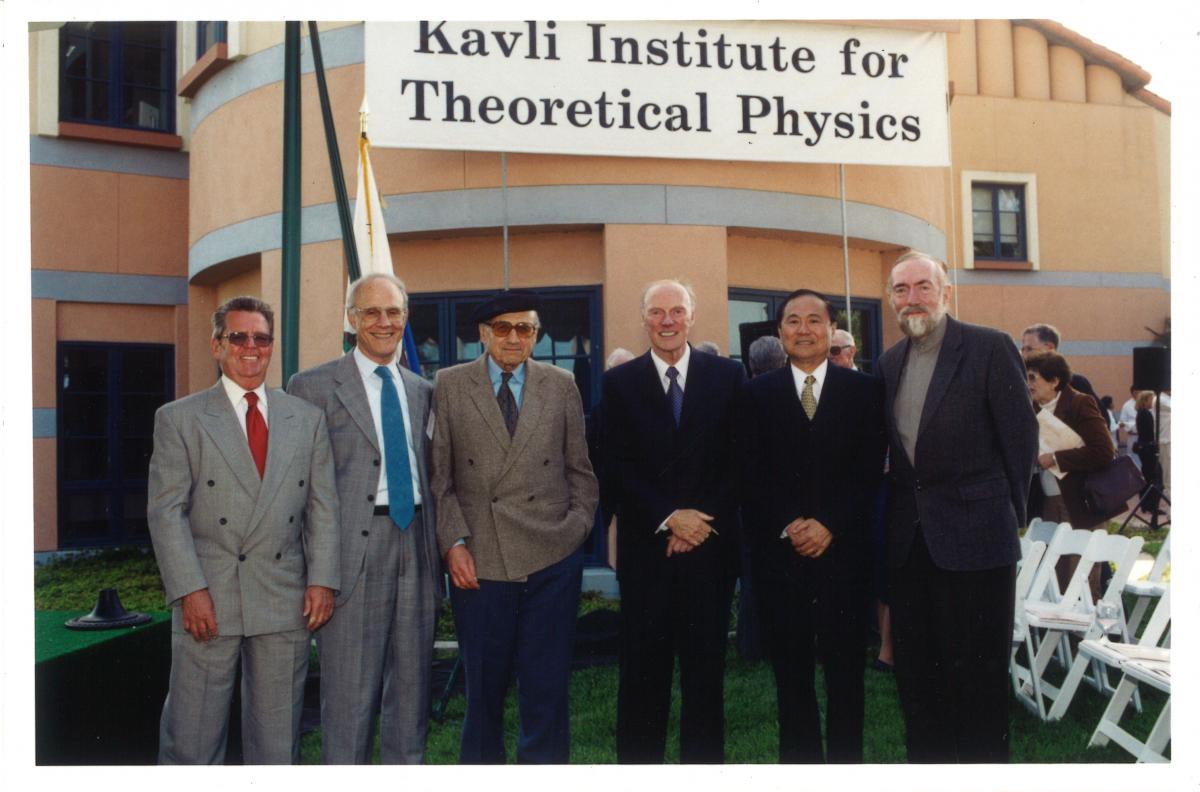 L-R: Frederick Gluck, then-Director David Gross, Walter Kohn, Fred Kavli, UC Santa Barbara Chancellor Henry Yang and Kip Thorne pose in front of the newly-renamed Kavli Institute for Theoretical Physics
L-R: Frederick Gluck, then-Director David Gross, Walter Kohn, Fred Kavli, UC Santa Barbara Chancellor Henry Yang and Kip Thorne pose in front of the newly-renamed Kavli Institute for Theoretical Physics
In 2021, topics include: “New Physics from Precision at High Energies,” “The Physics of Elastic Films: From Biological Membranes to Extreme Mechanics,” “Interacting Topological Matter: Atomic, Molecular, and Optical Systems,” “The Ecology and Evolution of Microbial Communities,” “Energy and Information Transport in Nonequilibrium Quantum Systems,” “Nonequilibrium Universality: From Classical to Quantum and Back,” “Probes of Transport in Stars,” and “Machine Learning and the Physics of Climate.”
Let’s take a quick dive into the 2020 Gravitational Holography program, as an example of what the programs involve. This program within the gravitational physics realm focused on black hole entropy. Black holes are formed when matter collapses into a volume small enough so that its gravitational field traps everything—even light. Black hole entropy is essentially a measure of the information hidden by the black hole.
“The concept of black hole entropy—proportional to the surface area of the event horizon—was introduced by Jacob Bekenstein almost 50 years ago to save the second law of thermodynamics,” explains Theodore A. Jacobson, a professor in the Department of Physics at the University of Maryland, and a frequent KITP visitor. “The second law of thermodynamics states that the total entropy of a closed system can never decrease.”
This move by Bekenstein “initially seemed to others as poorly motivated and desperate,” Jacobson says, “but was shortly thereafter strikingly confirmed by Stephen Hawking’s discovery that black holes have a temperature.”
While there still isn’t a complete understanding of the statistical nature of Bekenstein-Hawking entropy, Jacobson notes, progress has been made on several fronts over the years. And a major breakthrough occurred in 2019, with the discovery of the phenomenon of replica wormholes. Wormholes are curved tunnels connecting two distant places in a space—in this case, an auxiliary mathematical space containing multiple copies of the same distant place in real space.
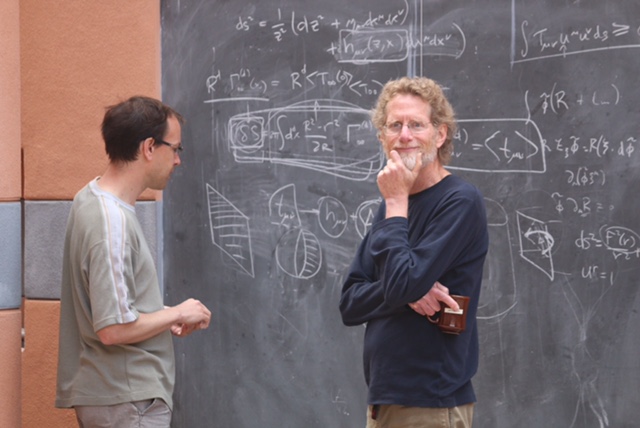 Professors Ted Jacobson with Mark van Raamsdonk during a 2015 visit to KITP
Professors Ted Jacobson with Mark van Raamsdonk during a 2015 visit to KITP
Photo Credit: Graham Farmelo
“Although still mysterious, this discovery indicates that the assignment of entropy to local regions of spacetime in quantum gravity is impossible because of the as yet not fully understood deeply nonlocal aspects of quantum gravity,” Jacobson says. “The puzzle of black hole entropy continues to serve as a focal point in the quest to unravel the workings of quantum gravity.”
The replica wormhole discoveries made in 2019 were published in several papers, and many of these authors then participated in KITP’s Gravitational Holography program.
As you can imagine, this type of work thrives within a collaborative environment. KITP provides an immersive physics experience, which includes hosting events year round, with 70 people in residence interacting both within their subfields of physics and across all of physics.
“By convening everyone who is actively working on a problem and having them argue and discuss it for months, you can move the field in new directions because of the rapid communication and sorting of ideas,” Bildsten points out. “That’s the hallmark of the institute and what established us, and it’s what we continue to do.”
One aspect of KITP designed to encourage this type of collaboration is the purpose-built facility that houses its visitors, thanks to a $65M donation by Charlie Munger. “We built a 75,000-square-foot facility so our visitors can live within the same building—families or singles—and keep working in the evenings and on weekends,” Bildsten says. “It takes away a lot of visitors’ stress about housing.”
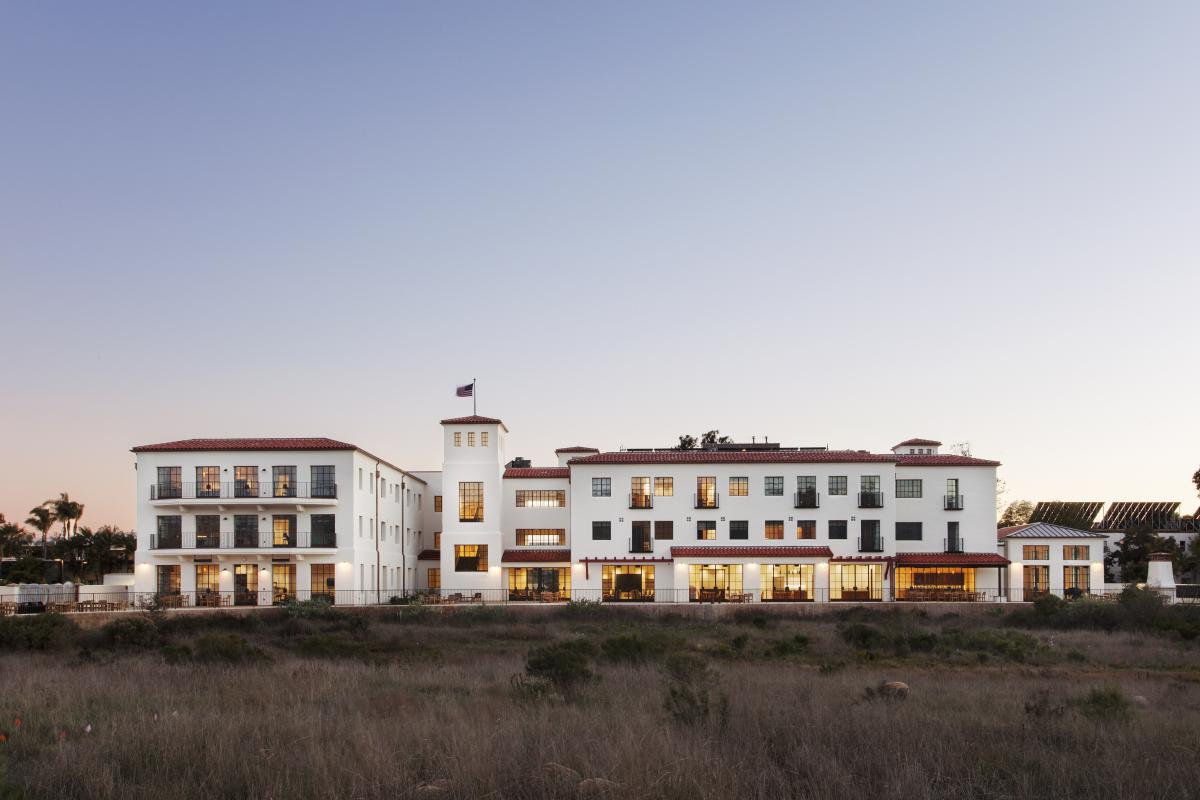 The Charles T. Munger Physics Residence hosts almost 1,000 visitors in a normal year, enabling the “casual science interactions” that are a hallmark of KITP
The Charles T. Munger Physics Residence hosts almost 1,000 visitors in a normal year, enabling the “casual science interactions” that are a hallmark of KITP
Photo Credit: James Brill
Since the start of the pandemic, KITP has been running all-virtual programs on Zoom.
“Although nothing will ever replace a live KITP program, going online offers new capabilities,” says KITP Deputy Director Mark Bowick. “We can be very inclusive by inviting all those interested in attending at all career levels.”
Participation is “extraordinarily high, with excellent talks, lively discussions, working groups, tutorials, and meet-and-greet sessions,” Bowick adds. “There’s great flexibility in responding to new developments within a given field.”
Author: Sally Johnson
